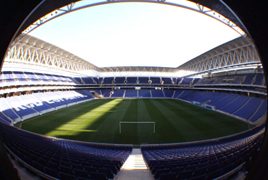The RCD Espanyol stadium in Barcelona is now a reality
- 40,000 spectators will be able to enjoy the new club facilities on August 2

The new stadium, located on the Plana del Galet, between the N-II and the Avenida del Baix Llobregat, at the height of the Plaza del Maresme, has been built by FCC in a joint venture for an amount of 65 million euros.
The official inauguration will be held on August 2, with a match between the blue and white team and Liverpool.
The project, designed by the architects Esteban Gasulla and Mark Fenwick, includes the stadium, with a capacity for 40,000 spectators, offices, a club museum, various premises for varied use and the construction of a two-storey car park for 250 spaces, as well as of the connections with the training grounds and the Cornellá field.
It consists of several areas: the bowl, made up of various tiered floors with rectilinear lines and a crystallographic appearance; the roof, a ring or perimeter wall, surrounds the bowl with a circular building, and the façade, which has been understood as a floating and translucent curtain that covers the different parts of the ring and supports the representative function of the club. All of this is achieved by incorporating an outer skin of u-glass type glass in white, blue and transparent colours, which allows filtered entry of natural light into the interior spaces.
The stadium has been designed under accessibility criteria for the disabled, complying with all its routes with the regulations, both inside the stadium and its surroundings, adapting a total of 0.5% of the seats inside; and from the point of view of efficiency and energy saving, presenting a roof made up of photovoltaic panels with a total area of 7,000 m2, also becoming an emblematic element together with the integrated low-consumption and high-efficiency luminaires, with about 650 megawatts. of power.
FCC's experience in the construction of football stadiums
The FCC Group has recognized experience in the construction of large stadiums throughout the world. Among its most outstanding references are the Allianz Arena in Munich, site of the official opening of the 2006 FIFA World Cup in Germany and one of the most spectacular stadiums in the world. He has remodeled and expanded the Santiago Bernabéu stadium, for Real Madrid; Vicente Calderón for Atlético de Madrid; the facilities of the Nou Camp, for the Fútbol Club Barcelona; the El Sardinero Soccer Field in Santander; the Joan Gamper Sports City, for Barcelona and the new sports city for Real Madrid, in Valdebebas. In 2007, he won the contract to build the new Valencia Club de Fútbol stadium, which will take over from the old Mestalla, with a capacity for 75,000 spectators.
Likewise, and on the occasion of the celebration of Euro 2008, FCC has carried out, through its subsidiary ALPINE, the remodeling and expansion of the Wals-Siezenheim stadiums in Salzburg, with 30,000 seats, the Tivoli in Innsbruck 31,600 and the Wörthersee in Klagenfurt, which has won the Construction Prize awarded by the State of Corinthia in Austria.
For Euro 2011, which is going to be held in Poland, FCC will build the Baáltic Arena stadium in Danzig, with 44,000 seats; the Poznan stadium in Posen, with 47,000 seats; the National Stadium in Warsaw, with 55,000 seats, and will remodel and expand the state of Krakow.








